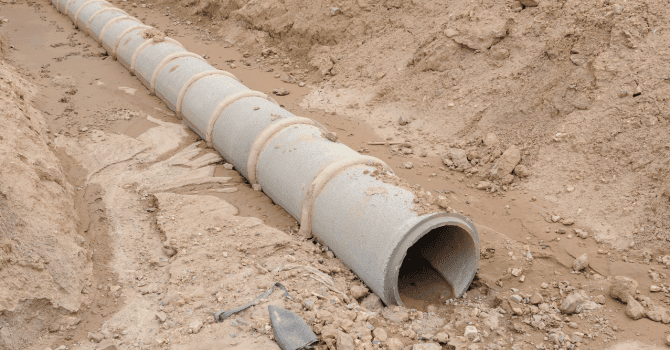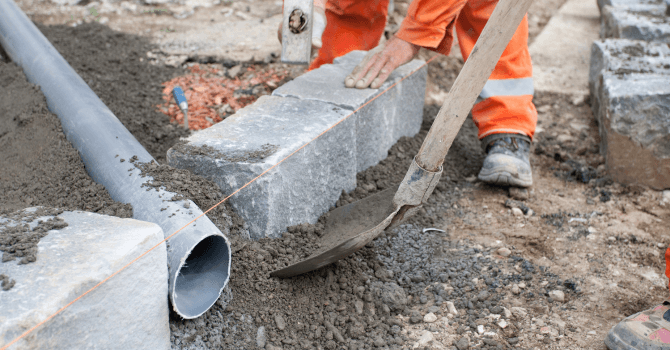
Depending on the circumstances of its installation, a French drain (or foundation drain) has a decent service life before it needs to be changed. You may be wondering if and when your drainage system needs to be replaced—check out this article for all the answers you're looking for!
When should your French drain be replaced?

Source: Canva
Replacing a French drain depends on several factors. First of all, regular system inspections are a must to detect any sign of damage or deterioration. If the French drain is leaking, frequently obstructed, or malfunctioning, it’s probably time to replace it.
What’s the service life of a drainage system?
The service life of a French drain can vary based on several factors:
Quality of materials used;
Regularly maintained or not;
Environmental conditions (corrosive soil, exposure to stagnant water, etc.).
Typically speaking, a well-designed and properly installed French drain can last on average between 20 to 30 years.
To maximize the service life of your French drain, it’s best to hire qualified professionals to carry out the installation and maintenance work.
If you begin to notice the following warning signs around the foundation of your home, or in your basement, it may be an indication that your French drain isn’t functioning properly. Process of elimination! First off, start by identifying the problem before undertaking a costly excavation and French drain replacement.
Lookout for These Warning Signs Around Your House and Basement
The presence of humidity hints at a problem
As a general rule, you should be on the lookout for any prolonged signs of moisture in the basement. A malfunctioning French drain will have a limited ability to redirect water that naturally collects near the foundation, which can lead to increased humidity in the basement.
If you notice a build-up of moisture on your drywall, or that your basement walls appear to be “sweating,” then you might have an excessive amount of water around the foundation of your home. However, that doesn’t necessarily point to a malfunctioning French drain.
In any case, the humidity level in your basement is probably too high and you might want to take the opportunity to rectify this problem. Take the necessary measures to lower the humidity level in your basement, if only for the sake of your personal health!
Check out the following article for more information: Causes and Solutions of Damp Interior Walls.
Concrete Efflorescence: Telltale Sign of the State of Your French Drain

Source: Canva
If you observe a build-up of white powder on the surface of your concrete, that’s a sure sign of efflorescence, which is an occurrence whereby the minerals in the concrete rise as a result of prolonged exposure to moisture.
If you notice a significant amount of efflorescence on the concrete walls of your basement over an extended period of time, this is most likely a foregone conclusion that something is faulty within the drainage system of your foundation.
It’s important to stress the presence of efflorescence over a significant period of time, especially in the basement. This is a natural phenomenon that may occur during periods of increased humidity, such as spring or fall.
For more information about efflorescence, check out our article: What Does Efflorescence Mean?
How to Determine if Your French Drain Is Working Properly or Clogged

Source: Canva
While you may not see any signs of humidity, water infiltration, or efflorescence, your property may still be showing other signs indicating a problem with the foundation drainage. If every spring you notice a lot of excess surface water on your property, yet your home is equipped with a French drain, have it inspected by professionals. Before undertaking any work, they will proceed with a camera drain inspection. Often, it just needs to be cleaned!
Camera Inspection
Prior to undertaking any work, they’ll check the entirety of the drain with a camera. Oftentimes, it simply needs a good cleaning!
The drain camera inspection can be performed via two entry points:
Through the catch basin (or sump), if you have one;
Through the drainage access chimney of the French drain.
Without a catch basin or drainage access chimney, the hired professionals may suggest digging a small access pit to allow the camera to travel to the French drain to begin the inspection. If it’s clogged, it can be cleaned with a drain cleaner.
Following the inspection, you should be able to determine if the French drain needs to be partially replaced due to a broken piece or completely replaced if it’s completely obstructed or damaged beyond repair. If it’s partially clogged, check with the on-site contractor to determine if it can be unclogged.
If you suspect the presence of iron ochre or if the on-site contractor points it out, replacing the French drain will have little impact on this natural occurrence. However, there are types of drains that are preferred for this particular situation.
For more information on how to proceed in such a situation, refer to our article on the subject matter. (French only)
When to Change a Foundation Drain: Overview

Source: Canva
The best advice to remember when it comes to replacing a French drain is to proceed by elimination: Check for signs of excess humidity and efflorescence in the basement, and have the inside of your French drain camera inspected. Having the entire French drain replaced should come as a last resort. You can either opt to have it cleaned, or partially replaced.
That being said, as mentioned at the beginning of this article, a French drain has a service life of 20 to 30 years. If you do the math based on when your house was built or know the exact year the French drain was previously replaced, it might need to be changed completely.
A section of the drain can indeed be replaced, but if it has reached the end of its service life, all other sections will need to be replaced at some point or another. Replace it completely, or risk having to repair it constantly, which will become more expensive in the long run.
Check out this article for additional information:
Get 3 renovation quotes for your foundation and French drain project
RenoQuotes.com can help you get quotes for a foundation and French drain project. By submitting your project, we’ll put you in contact with top-rated contractors. Fill in the form on the homepage (it only takes a few minutes), and you will get estimates from trusted professionals.
Dial 1-844 828-1588 to speak with one of our customer service representatives.
Looking for something else?
Related articles
The latest industry news, interviews, technologies, and resources.

Editorial Team
•01 Aug 2024
If you noticed significant changes in your house and detected a structural shift over time, the odds are that the stability of your foundation has been weakened. By that, we mean that the foundation may have collapsed. The latter may be the result of the soil, which can’t adequately bear the load of the structure, the presence of clay soil, a water table, or full-grown trees, whose roots have reached the outer walls of the foundation.

Editorial Team
•09 Jan 2024
Regardless if it’s large or small, almost every renovation project is going to involve careful planning, close attention to detail, patience and perseverance. For the novice builder among us, you may not understand what each stage of a building project entails. If you’re hoping to take on a frame alteration, a renovation or a completely new build, there are some aspects you’ll need to consider.

Editorial Team
•13 Sep 2024
Mineral wool is an effective structural insulation material. In fact, by 2030, its global market, which is valued at no less than 15.6 billion dollars, could grow by as much as 6%.
Editorial Team
•31 Mar 2025
Are you considering elastomeric membrane roofing for your flat roof, but unsure about its benefits and potential drawbacks? In this article, we answer important questions like: What are the costs and lifespan of elastomeric membrane roofing? How does it compare to other materials, and how is it installed?

Karine Dutemple
•07 Nov 2024
Whether we’re talking about small or large-scale projects, managing a building or a renovation project is not always obvious and it’s really easy to get overwhelmed. Whether it’s for organizing, reaching out to contractors or final decisions, everything can seem like a real puzzle.